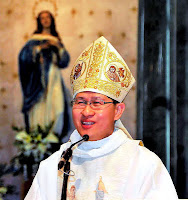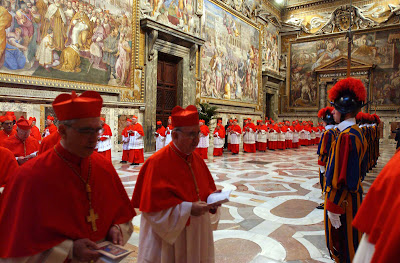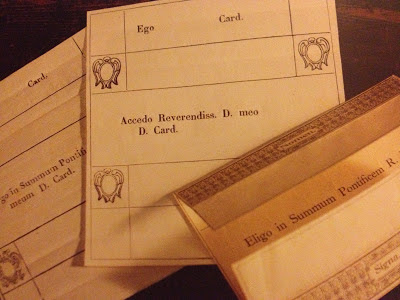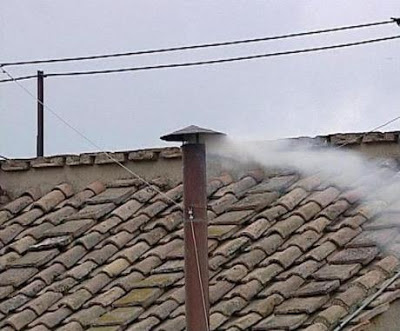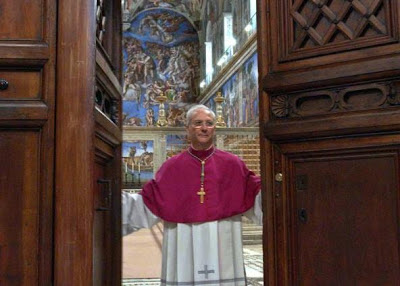 |
As you likely already know (especially if
you follow this blog, as it’s just about all I can think about right now) the
papal election is only a day away. It’s probably about time we take a look at
the front-runners before we Roman Catholics head to the polls. Oh, right, I
forgot. We don’t get to pick our leader.
Be that as it may, I know that when I’m standing
in that crowd of 100,000 or more people in St. Peter’s Square, waiting for the
name of the new pope to be announced, I’m going to want to know whether to cheer
with abandon and hope for the future of the church, or shake my head and think,
“More of the same…”
After my last two mega-posts (particularly yesterday’s ridiculous 3,162-word tome that took me nearly literally the
entire day to write), my solicitous maritino
tactfully suggested that if I wanted my readers to actually read my posts (all
the way through), I’d do best to consider shortening them just a tad. And as
unpleasant as it is to admit your spouse is right, I think he is. Now, if
I had a typical Italian husband, this is where I’d probably insert a
joke about him only being concerned that my over-zealous blogging was
preventing me from preparing his beloved nightly pasta. No, dearest bloglings,
not even a hint! Yes, I got one of the good ones, but more on that another time
(definitely after conclave).
So back to our friendly cardinals, one of
who will have, in just a few days, the power to change the world. In Italian, a
cardinal who is considered a strong candidate for the papacy is called a papabile (plural: papabili), literally pope-able. Frankly, I prefer Stephen Colbert’s
term, “Popeful.”
Out of the 115 cardinal-electors
participating in conclave this year, there are according to some up to 30 papabili, although for reasons mentioned
above, I will be writing a much more abbreviated list.
Card. Scola is the clear front runner for
this race. He’s got what some people consider the perfect combination of an
Italian with tons of experience, and yet someone who has never actually worked
inside the Vatican, so he can’t be blamed for the recent mismanagement of the
Church. Out of all the others, he is the cardinal
considered most likely to gain the 2/3 majority. But in Rome there is an
expression, “He who goes into a conclave a pope, comes out a cardinal.” So maybe we shouldn’t bet on Scola yet. (Although he’s being given excellent odds
with the bookies in town!) What could go against him: his name was dropped in the
Vatileaks scandal last year as someone who should replace Benedict XVI.
A few weeks ago, I predicted Card. Sandri
for pope, and I still think he has a good shot, but in recent weeks, it’s
seeming less likely. No one seems to be talking about him. Still, to me, on
paper, Sandri is the ideal candidate. He covers all the bases for what it is
believed the cardinals are looking for in the future pope: as a South American
he has a deep understanding of the church outside Europe, but he has also spent
most of his life in Italy and has worked as an high-level administrator in the
Vatican. He proved himself as a good organizer when he worked directly under
John Paul II. What could go against him: he could be blamed for the poor
organization in the Vatican of recent years (although he left his previous
position several years ago).
If Card. Sandri is who I think could become pope, Card. O’Malley
is who I hope will become pope. I was
first introduced to him by Patricia Thomas on her wonderful blog, Mozzarella Mamma, which I have mentioned
several times lately. Read her post on him, as she is a fan as well, for much more
insight than I could hope to give. I just have a gut reaction to O’Malley.
First of all, he’s a monk, and you can’t get much humbler than that. He shuns
the Cardinal red and instead wears a simple cassock and hood of a Capuchin as
he goes about his business here in Rome. He took over in Boston after the
Bernard Law fiasco, and has worked tirelessly advocating for the victims of sex abuse by priests. What could go against him: he is well known for his
reputation as a reformer, and the big Italian bloc inside the Vatican curia will
do anything to keep him from becoming pope and challenging their status quo.
But miracles can happen!
Card. Dolan is an energetic powerhouse of a
cardinal, and despite being a dreaded American, he is generally well liked by
the Italian faction. The Italian paper La Repubblica calls him a “shadow
candidate,” as he could be a potential compromise candidate for the two
opposing factions, being called the Romans vs. the Reformers. While certainly
not as change-hungry as O’Malley, Dolan has acknowledged that the church is in
crisis and some reform is necessary. What I like about him is that he gets
things done. He prefers to do things himself, instead of delegating them to
others, which can only be a good thing. What could go against him: he is seen
by some as “too American,” with little understanding of the rest of the world,
and very poor foreign language skills.
There has been lots of talk lately about
this Brazilian candidate of German descent. He is highly favored to be elected,
particularly because of his close ties with those in power in the Vatican curia. But my mother always said, “If you can’t say anything nice, don’t say anything at
all,” so… Next!
I’d like to imagine a Roman Catholic Church
in which a man like Cardinal Tagle could be elected. Vatican expert John L.
Allen says that if the cardinals’ first priority were to have a pope who would
be a moving, rousing evangelizer, capable of “setting people on
fire with enthusiasm for the faith, and if they wanted that evangelizer to
come from outside the West," Tagle would be the obvious choice. He is only 55
years old, and widely considered the most charismatic and dynamic candidate,
and is also admired for his simplicity and humility, (he gets around only by bike or on public transport). What could go against him: there are very few
electors from Asia, and without a strong faction behind him, he will have a
hard time gaining the 2/3 majority. He also is very unfamiliar with the
workings of the Vatican. (Or maybe that’s a good thing?)
Card Ouellet’s combination of fierce
intellect, near-fluency in six languages, and several years of missionary
experience in Colombia makes him a very interesting candidate for pope. To that
he combines years of experience inside the Vatican. What could go against him: He
is said to radiate prayerfulness and spirituality, which you would think would
be ideal characteristics in a pope, but some think he might be overlooked
because his inherent goodness might make it difficult for him to make the tough
decisions that inevitably await a pope.
John L. Allen, in his series of articles, Papabile of the Day, the Men who could be Pope, describes Card. Schonborn as “either an obvious,
slam-dunk contender or somebody who's basically taken himself out of the
running.” He’s something of a wild card, and not the most diplomatic of
cardinals, but he has spoken out strongly against the sex abuse issues inside the
church (he, along with Card. Tagle, are the only two papabili not implicated in any way in any of the sex abuse
cover-ups). In fact, he stirred up more than a little trouble with Secretary of
State Bertone and some other big-wigs in the Vatican curia, and he is
definitely not in their good books. This might just work in his favor for those
cardinals who are desirous of a change to the “old guard” and looking for
someone who has no qualms about standing up to his opponents. What could go
against him: those very same big-wigs will stop at nothing to prevent him from
becoming pope, as they would probably all lose their cushy positions. Perhaps
even more damning, the situation in Austria is a mess, which makes it look like
he’s lacking in the all-important organizational and administrative department.

Cardinal Peter Turkson of Ghana. President for the Pontifical Council for Justice and Peace.
Getting the number three best odds with bookies is the friendly, popular and dynamic Card Turkson, the most likely out of all the African candidates. Turkson is favored both for his long pastoral experience of 17 years in the the diocese of Cape Coast, and for his administrative skills, proven in his current post. In addition, he conveniently answers the desire for a pope to represent the most growing Catholic population, yet without being an outsider. Another plus is his advocation for Catholic/Muslim relations, a very timely plus on his resume. What could go against him: a few recent shenanigans have asked many to question his judgement. He once showed biased and already discredited YouTube video on Muslim immigration in Europe at a synod, he has made questionable remarks linking homosexuality with pedophilia, and some claim he is unabashedly campaigning for the papacy (posters with his face mysteriously appeared around Rome with the words "Vota Turkson").
Whoever is elected in the coming days (or
weeks?), I think just having so many far flung countries represented on this
list is a very good sign for the future of the Church. But what about you? Who
do you think will be the next pope? Someone on this list or one of the number
of other papabili? I’d love to hear
who you’re predicting and why, so please leave a comment! (If you can't find the comment button, click on the title of the post and it should appear at the bottom.)
PS If you want to take a more active role
in this conclave, you can adopt your very own cardinal! I’m not kidding. This website
will assign you a cardinal-elector at random to pray for during conclave. Over
200,000 people have already signed up.
More conclave posts:
Image sources: 1, all others







